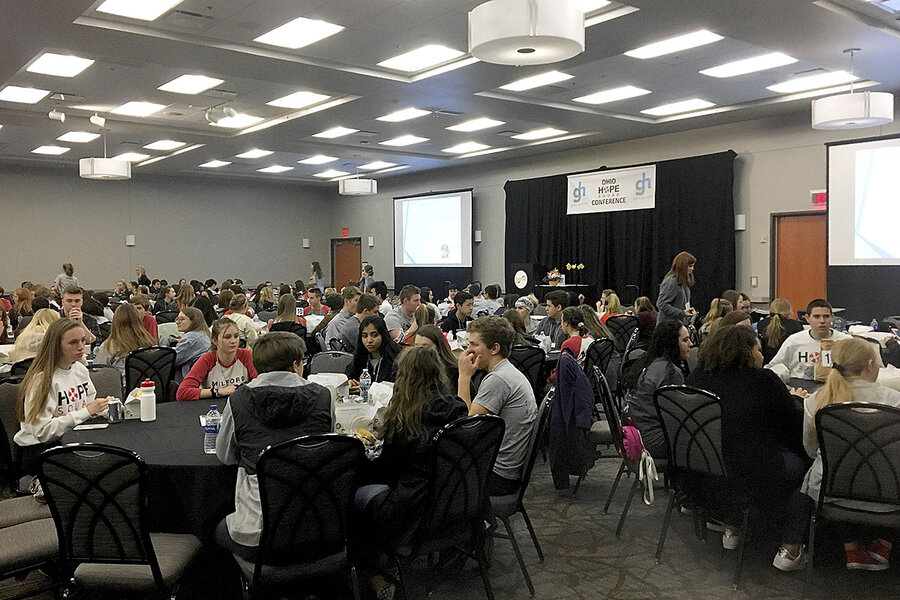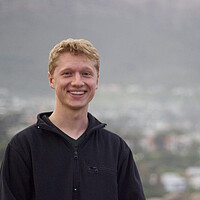When counselors are in short supply, students step in to help
Loading...
It isn’t difficult for high school sophomore Kason Jacquez to spot students who need to talk. They might be visibly upset, or spending all of their time alone – or maybe they just don’t ever accept a compliment.
Kason is better equipped to support them now thanks to a national organization, Hope Squad, which trains students to watch for suicide warning signs and refer at-risk peers to professionals. His Arizona district is the first in the state to enlist the help of the group.
Why We Wrote This
Schools in the United States face a dearth of counselors, who sometimes are assigned more than 700 students. Peers are being trained to fill some of the gaps. Can young people, no matter how well meaning, make a dent?
Peer counseling isn’t a new concept – hope squads were born two decades ago. But the idea is emerging as one approach to meeting mental health needs in K-12 and higher education. Although they can’t tackle every problem, students can help with basic services – especially in high-needs and rural districts.
“Many students that go into the counseling department just need to talk. They don’t necessarily need professional help,” says Jennifer Wright-Berryman, suicidologist at the University of Cincinnati and lead researcher for Hope Squad. Peer counseling, she says, can help “take some of that workload off of counselors that might otherwise see those kids.”
About an hour from the U.S.-Mexico border, in St. David, Arizona, something new is growing in the desert: hope.
Mental health has been a focus for this town of fewer than 2,000. Melanie Larson, the nurse for the St. David Unified School District, says many students experience anxiety and depression. Two counselors support them, but each comes in only once a week. The rest of the time, Ms. Larson serves as both nurse and counselor to a student body of about 420.
A few years ago, after two St. David adults – one a recent high school graduate – died by suicide in close succession, the district enlisted the help of Hope Squad. The national organization trains selected students to watch their peers for suicide warning signs and refer those at risk to professionals. St. David is the first district to enlist the approach in Arizona, tapping Ms. Larson as the coordinator.
Why We Wrote This
Schools in the United States face a dearth of counselors, who sometimes are assigned more than 700 students. Peers are being trained to fill some of the gaps. Can young people, no matter how well meaning, make a dent?
Peer counseling isn’t a new concept – hope squads were born two decades ago. But the idea is steadily emerging as one approach to meeting mental health needs in both K-12 and higher education. Students can’t tackle every problem their peers experience, but they can help ease the pressure on professionals for basic services – especially in high-needs and rural districts.
“We definitely have schools that are seeing the relationship between trauma, bullying … perfectionism, and mental health disorders,” says Jennifer Wright-Berryman, suicidologist at the University of Cincinnati and lead researcher for Hope Squad.
“All those things can contribute to suicidality. And now that schools are becoming wiser to those variable relationships, they’re like ‘Wait we really need to focus on getting some suicide prevention into our schools,’” she says.
Nearly all of the teens recently surveyed by the Pew Research Center reported anxiety and depression as problems for people their age in their communities. While mental health awareness is growing nationally, school counseling services haven’t kept pace. The American School Counselor Association recommends a ratio of 250 students for every one counselor. Except for Montana, New Hampshire, and Vermont, all states exceed that rate, and Arizona tops the charts with an average of 758:1, according to a recent report from the American Civil Liberties Union.
“Many students that go into the counseling department just need to talk. They don’t necessarily need professional help,” says Dr. Wright-Berryman.
Peer counseling can help “take some of that workload off of counselors that might otherwise see those kids,” she says.
Learning to step in
It isn’t difficult for high school sophomore Kason Jacquez to spot those kids. They might be visibly upset, or spending all of their time alone – or maybe they just don’t ever accept a compliment. Before Hope Squad came to St. David, he often noticed them.
“You could walk in the hallway and be able to pick out people pretty easily … during practices and things like that and you could just see people that were struggling,” he says in a phone interview.
But Kason didn’t always know what he could do to help. He has experience with mental illness in his own family – he says his aunt had depression and ultimately died by suicide. When Hope Squad came to his school, his classmates nominated him for the program.
The group meets weekly, offering guidance on how to approach someone in need and when to reach out for assistance from an adult.
Not every conversation needs to start by talking about mental health. Sometimes, Kason says, he begins by saying, “‘How are you?’ or ‘You know, I haven’t heard you laugh in a while,’ or just complimenting them to get them at ease.”
Breaking stigmas
The Young Adult Connect Initiative, organized by the National Alliance on Mental Illness (NAMI) in New Hampshire, is spreading similar skills. For almost a decade, the organization has been training high schoolers across the country to pay attention to the social-emotional well-being of their classmates. It's now in its second year extending the training to young adults up to age 25.
Ann Duckless, NAMI New Hampshire’s community educator and prevention specialist, says she’s encouraged by how younger people seem more open to discussing suicide.
The newest generation of adults is more susceptible to mental health issues, she says. ”Part of that is really the connectedness to technology and just the stress of 2019.”
But on the other hand, they “are so much more savvy and sophisticated on these issues. ... They have a much better understanding of mental health, substance use, and suicide risk than previous generations,” she says.
The Westgate Community School, a K-12 charter school in Thornton, Colorado, has begun its own peer counseling program, started by the assistant principal for grades 7 through 12, Amanda Novak. She helps connect students of all ages with trained high school mentors.
Her program aims to make counseling interactions feel more informal – although Ms. Novak or other adults still supervise. The group, now four years old, has become so established that many mentees have it listed in their Individualized Education Program (IEP) as a special social-emotional accommodation. Some have even become mentors themselves.
Persistent challenges
But peer counseling can ultimately only go so far. The mental health needs facing many school districts extend beyond students’ abilities, says Amir Whitaker, staff attorney with the American Civil Liberties Union of Southern California.
“The fact that we’re even talking about peer counseling just shows the lack of investment,” says Dr. Whitaker. In other countries, “they’re probably making enough investment to where there are enough professionals to meet the needs of students.”
He does still support evidence-based peer counseling, but argues fixing professional shortages will take reprioritizing mental health funding.
Dr. Whitaker’s report points out that while schools reported a 5% increase in the number of counselors to the National Center for Education Statistics from 1999 to 2015, students reported a 15% increase in the number of security guards and police during the same time.
Ms. Novak agrees that comprehensive mental health services extend far beyond peer counseling. Meeting with students who have severe needs, working on IEP requirements, and completing suicide risk assessments all fall to trained professionals exclusively. Peer counselors can’t ease those burdens.
Despite the obstacles, many students still report that peer counseling is helping push a necessary cultural shift. Recently the St. David hope squad organized a spirit week, where students dressed in wacky outfits each day of the week to drum up excitement around improving mental health.
This year, it couldn’t compete with homecoming. But the squad is still optimistic.
“There’s good things in life,” says Kason. “I can make a difference for those people that are struggling.”
If you are in crisis please call the National Suicide Prevention Lifeline at 1-800-273-Talk (8255) or text TALK to 741-741.








